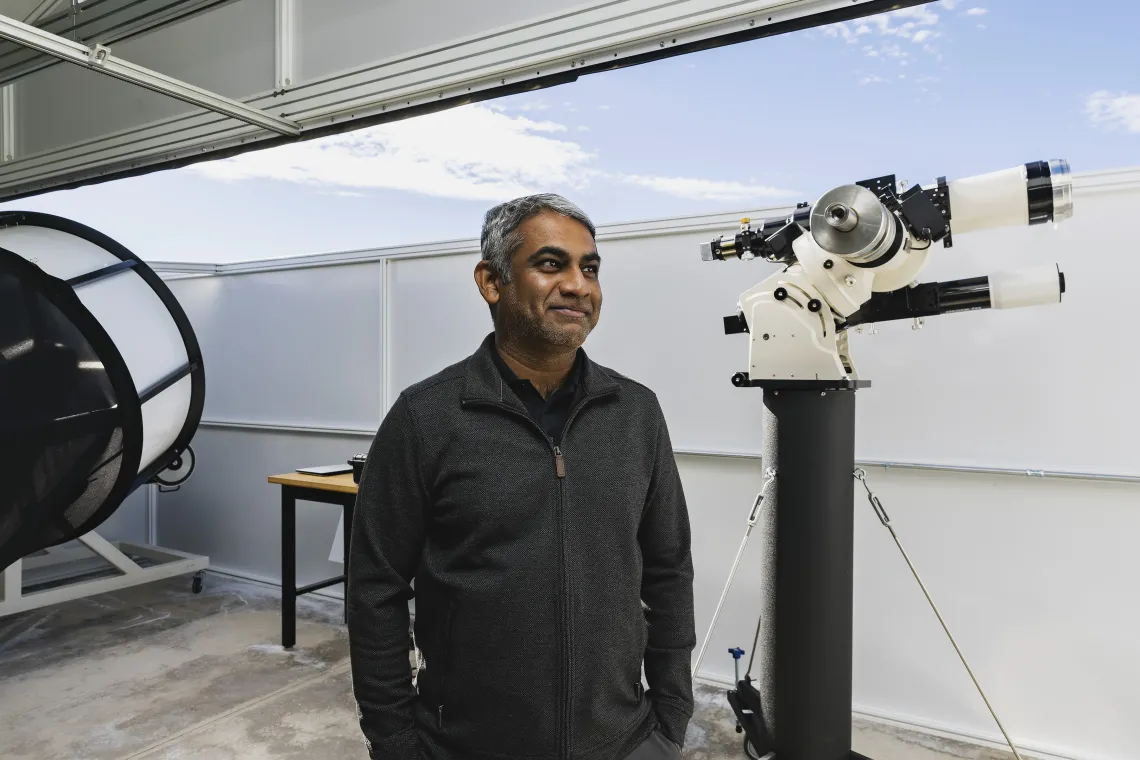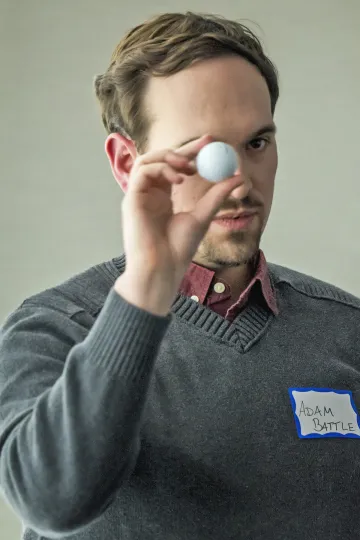Studying Nuclear Waste Orbiting Earth for Space Safety

Vishnu Reddy, UArizona planetary sciences professor and Space4 director, took on the challenge of studying highly volatile and highly reflective Earth-orbiting blobs of sodium potassium, or NaK, when he joined the University in 2016. Photo by John de Dios.
Graduate students and faculty associated with the University of Arizona’s Space4 Center are using nuclear coolant waste to fill a critical gap in space situational awareness and improve safety for future space missions.
Their research focuses on small bits of space junk that are difficult to see but large enough to damage spacecraft—objects with a diameter of 1 to 10 cm, dime- to grapefruit size, whizzing around in low-earth orbit, or LEO. LEO is home to the International Space Station, the Hubble Space Telescope and megaconstellations like the internet provider Starlink.
Using highly volatile and highly reflective blobs of sodium potassium, or NaK, that are orbiting Earth, the team has demonstrated the ability to track and study small, shiny objects with a small, student-built telescope—a first in the space situational awareness community.
“With the proliferation of megaconstellations, or large networks of satellites, in LEO, understanding the centimeter-sized debris population becomes critical for space sustainability—managing space traffic. These NaK blobs represent a population of such debris that are readily available for us to study and test our tools,” said Vishnu Reddy, professor planetary sciences in the Lunar and Planetary Laboratory, or LPL, and director of the Space4 Center.
Adam Battle, an LPL graduate student who is funded by the Space4 Center and works with Reddy on the project, said many of these objects are not tracked by any entity.

“We don’t know much about them, and they can destroy spacecraft,” Battle said. “This is about space traffic management and pushing the capabilities to track and characterize smaller and smaller objects in the orbital debris population.”
The work was seven years in the making. When Reddy joined LPL in 2016, one challenge he wanted to tackle was finding a way to study the NaK in orbit around Earth, waste from the Soviet RORSAT program.
RORSATs were LEO radar reconnaissance satellites used to monitor ocean traffic. The Soviet Union launched 33 of these satellites between 1967 and 1988 at a relatively low altitude and used nuclear reactors for power. When the satellites were successfully retired, the reactors were ejected into a higher altitude graveyard orbit, where they leaked the liquid metal NaK coolant used in the reactor.
“I first wanted to do laboratory characterization of these coolant debris and quickly realized that they are not safe to handle,” Reddy said. “So, I decided it is safer to study them with telescopes.”
NaK explodes when exposed to water and may catch fire when exposed to air, making it difficult to study on Earth. Although most of the estimated 1 million droplets have decayed into Earth’s atmosphere, approximately 10,000 that are 1 cm or larger will remain in orbit for several decades.
Objects with a diameter of less than 1 cm generally don’t pose a hazard to spacecraft, and the US Space Surveillance Network can track debris larger than 10 cm in diameter using optical telescopes. The network uses radar to detect—but not track—debris smaller than that because the objects are too faint and are moving too quickly to be seen with optical telescopes.
“If an object 1 – 10-cm hit a satellite on the order of a kilometer per second, it would be like a bullet,” Battle said.
More than 25,000 objects larger than 10 cm are known to exist, according to NASA. An estimated 500,000 objects in the 1 to 10 cm range are in Earth’s orbit. These orbital debris include flecks of paint and other pieces and parts of spacecraft and, to a much lesser degree, the NaK droplets.
Although most of the estimated 1 million droplets have decayed into Earth’s atmosphere, approximately 10,000 that are 1 cm or larger will remain in orbit for several decades, posing a potential danger to spacecraft, Battle said.
Closing the 1- to 10-centimeter gap in tracking capabilities and better understanding the makeup of the droplets meant assembling the necessary instruments.
“Tracking these objects let alone finding out their reflectance properties is extremely challenging,” Reddy said. “Our existing telescopes were not capable of tracking fast moving debris like these nuclear coolant waste in low-Earth orbit, so we had to build a new telescope and develop new techniques.”
In 2021, with the help of local business Starizona and five undergraduate engineering senior design students, Reddy built a small-aperture telescope capable of tracking, or following, LEO debris in orbit. Over the next two years, Reddy and Battle developed the technique to find out the properties of these NaK blobs using their reflected light.
The team used the student-built telescope based at the Space Domain Awareness Observatory at the Biosphere 2 facility near Tucson, AZ, to capture the spectral signature – the specific way light is reflected or bounces off a surface at each wavelength – of 20 of the 10-cm blobs to learn more about the surface of these objects. The researchers also measured the objects’ brightness to better inform future orbital debris studies.
Photo caption: LPL graduate student Adam Battle holds a golf ball, demonstrating the size of some of the NaK blobs he has studied. Photo by John de Dios.

